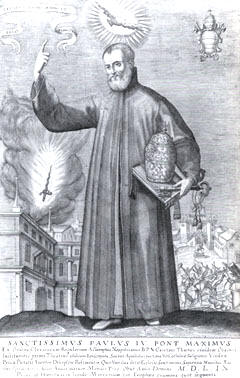 Under Marcellus reform had begun to stir Rome like an insistent but gentle
breeze. Under his successor reform roared through the city with all the
violence and some of the freakishness of a tornado.
Under Marcellus reform had begun to stir Rome like an insistent but gentle
breeze. Under his successor reform roared through the city with all the
violence and some of the freakishness of a tornado.
Giovanni Pietro Caraffa was born near Benevento on June 28,1476, of a noble
Neopolitan family. With his connections advancement was easy. He served Leo
X as diplomat in England and Spain. He was a zealous bishop of Chiete; but
dissatisfied with the comfortable life of a Renaissance prelate, he yearned
to be a Camaldolese monk or a Dominican friar. He finally persuaded Clement
VII to let him join the new order of Theatines founded by his friend St.
Cajetan. Caraffa became general of the order, the object of which was to
promote the welfare of the secular clergy. Paul III used both the order and
Caraffa to further his reform projects. Indeed Caraffa became Paul's right-
hand man in matters of reform. Created cardinal in 1536, and archbishop of
Naples soon after Caraffa worked furiously to carry out the reform plans of
his chief.
Caraffa was chosen Pope after a stubborn election May 23, 1555. He was an
old man of seventy-nine, but a vigorous old man, full of fire and fight. He
took the name Paul IV. Though deeply religious, Paul IV was hot-tempered,
had small understanding of human nature, and was too fond of his relatives.
These relatives caused him grief, for they disgraced the high positions he
gave them. But to do Paul justice, when his eyes were opened, he ruthlessly
disgraced them.
Paul was extremely anti-Spanish, and soon was involved in a disastrous war
with Philip II. By 1557 the Pope was soundly beaten, and when let off with
easy terms, he prudently decided to spend more time on spiritual
activities. Paul IV had already begun to work on reform. With furious zeal
he swung the ax, cutting down expenses and his own revenues. He gave good
example too by his private life, which was pious and austere.
Paul had a horror of heresy which surpassed even his horror of abuses. As
cardinal he had urged Paul III to reestablish the Roman Inquisition, and
now under his eager hands it leaped into high gear. When he extended its
competence to cover moral cases as well as heresy, Rome trembled. When it
came to heresy, Paul had an enormous capacity for suspicion. He jailed
Cardinal Morone, a truly great prelate, on suspicion of heresy. He recalled
Cardinal Pole from England where he had just reconciled that country with
the Church to answer the same charge! Small wonder ordinary men shook.
Paul IV died August 18, 1559, admitting his faults. But in spite of them,
he did much for the Church. Many of his reform decrees were adopted by the
Council of Trent. His harshness was resented by the Romans, who threw down
his statue and attacked the Inquisition Office to celebrate his death. But
this very harshness cleared away any last remnants of the pagan miasma
which afflicted Renaissance Rome. The best epitaph for the fierce old
reformer was the statement of the Venetian ambassador--that in his reign
Rome had been turned into a monastery.
Excerpted from "Popes
Through the Ages" by Joseph Brusher, S.J.

